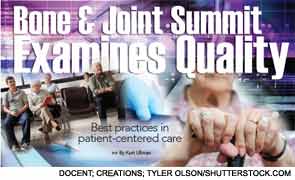
In 2001, President George W. Bush proclaimed 2002 to 2011 the Bone and Joint Decade in the U.S. The effort was deemed so successful that the U.S. Bone and Joint Initiative (USBJI) was created to continue the work.
“The USBJI is essentially an organization of organizations with most of the major stakeholders involved,” says David Pisetsky, MD, PhD, professor of medicine at Duke University Medical Center, Durham, N.C. “It is multidisciplinary in nature, including not only rheumatologists and orthopedic surgeons, but other providers, such as physiatrists, occupational and physical therapists, nurses, members of industry, payers, as well as patients, their families and advocates.”
The Initiative’s 2013 Musculoskeletal Summit was held Nov. 18–19, 2013, in Washington, D.C., and focused on best practices in patient-centered musculoskeletal care.
“The last summit, two years ago, was on value in the care of patients with these diseases,” notes Dr. Pisetsky who was one of the chairs of the meeting and spoke with The Rheumatologist following the summit. “From that basis, it was thought that to have a good understanding of value, you also have to be able to define quality. Especially in the context of a healthcare system undergoing major changes.”
Best Practices
The meeting delved into defining best practices and patient-centered care, as well as implementing best practices in clinical settings, ranging from large systems to individual practitioners. The second day discussed in more detail specific conditions, such as fracture prevention and back pain.
“This was a great opportunity for different stakeholders in musculoskeletal medicine to interact and exchange viewpoints across the field,” says Kenneth Saag, MD, MSc, Jane Knight Lowe professor of medicine at the University of Alabama at Birmingham. “There was quite a bit of cross-pollination [among] those involved, some of whom don’t necessarily communicate with each other on an ongoing basis.”

Dr. Saag participated in the session that considered how to define best practices, what evidence should be used in determining guidelines and how to establish, disseminate and implement them.
“Guidelines provide a way to summarize the state of the art for busy practitioners,” he says. “They help capture where we stand in the science behind clinical decision-making.”
Those in attendance suggested a need for additional systematic reviews to identify both existing evidence and implications for treatment. Attendees also expressed the view that quality measures should shift away from the process of care to methods for improving care quality. Among these methods are the use of information technology to generate clinically relevant cost data, identifying variables that indicate value and improving patient registries.
Importance of Care Systems

“Another important discussion concerns the importance of systems,” says Dr. Pisetsky. “Healthcare is heterogeneous in its organization. Who takes primary responsibility, for example, when a patient leaves the care of a surgeon and returns to general care?”
“System” does not necessarily mean a specific hospital or healthcare entity, although specialty hospitals can provide comprehensive care. Their singular focus promotes development of best practices across the continuum of care.
“Rheumatology patients often require ongoing care as they cope with a variety of health challenges and complications,” says Mary Kuntz Crow, MD, physician in chief at the Hospital for Special Surgery in New York City. “Collaborative and coordinated clinical care can achieve optimal outcomes. This includes timely care by the most appropriate provider, lower complication rates, fewer readmissions and higher levels of patient satisfaction.”
If this level of specialization is not available, systems become even more important because they can ensure a person’s needs are met even though they cross multiple disciplines.
Dr. Pisetsky cites a person with osteoporotic fractures as an example. The orthopedic surgeon initially fixes the patient’s fracture. After discharge, however, there may be no clear delineation of who treats the osteoporosis.
“Historically, [fewer] than one patient out of every four with fractures are tested or treated for osteoporosis,” says Dr. Saag. “The data also say that there is a strong benefit from beginning antiresorptive therapy. The establishment of programs such as fracture liaison teams can address many of these issues.”
The importance of systems increases with patient age because an older individual may have four or more comorbidities in addition to those involving the bones or joints. All may need attention for the best musculoskeletal outcome.
Patient-Centered Treatment
Patient-centered treatment was also considered by the Summit. These discussions highlighted such needs as ways to address the goals of both the patient and their family in light of population health goals and the role of the USBJI in creating tools to help patients and their families advocate for themselves.
“Especially in areas where there hasn’t been a push to develop systems for treating joint and bone diseases, patients may have to navigate from provider to provider,” says Dr. Pisetsky. “How do you find what is the best care for your disease and then advocate for yourself, not only across the system but also with the individual providers?”
An important aspect of patient-centered care relates to the diversity of the population and differences among patients with respect to gender, as well as racial and ethnic groups. These differences have an impact on many aspects of care, as well as communication among patients, their families and providers. Because the goal of improved musculoskeletal health is lifelong, special programs may be needed for children—especially because childhood is a time of bone growth and development.
Report Sets Forth Priorities
A summary report with recommendations based on the discussions undertaken at the Summit is under development. This report will set out the priorities developed during the meeting and establish a framework for future work. When complete, it will be available through the USBJI’s website at www.usbji.org.
Dr. Pisetsky hopes the report brings attention to the importance of patient-centered care and encourages providers to establish or refine systems addressing the needs of patients with musculoskeletal conditions and their families. He also feels the report will provide a blueprint for advocacy activities at all levels from contact with a provider to interactions with large systems and governmental agencies.
“With quality as a key goal in musculoskeletal care, the report will provide important guidance on reaching it,” Dr. Pisetsky says.
Kurt Ullman is a freelance writer based in Indiana.
